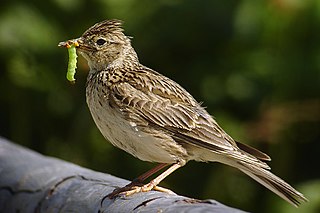
The Eurasian skylark is a passerine bird in the lark family, Alaudidae. It is a widespread species found across Europe and the Palearctic with introduced populations in New Zealand, Australia and on the Hawaiian Islands. It is a bird of open farmland and heath, known for the song of the male, which is delivered in hovering flight from heights of 50 to 100 metres. The sexes are alike. It is streaked greyish-brown above and on the breast and has a buff-white belly.

The white-winged lark is a species of lark found from southern Ukraine through Kazakhstan to south-central Russia. It is partially migratory, with birds tending to move south in winter. The southernmost birds are mainly resident. It is a very rare vagrant to western Europe.

The crested lark is a species of lark distinguished from the other 81 species of lark by the crest of feathers that rise up in territorial or courtship displays and when singing. Common to mainland Europe, the birds can also be found in northern Africa and in parts of western Asia and China. It is a non-migratory bird, but can occasionally be found as a vagrant in Great Britain.

Thekla's lark breeds on the Iberian Peninsula, in northern Africa, and sub-Saharan Africa from Senegal to Somalia. It is a sedentary (non-migratory) species. This is a common bird of dry open country, often at some altitude. Thekla's lark was named by Alfred Edmund Brehm in 1857 for his recently deceased sister Thekla Brehm (1833–1857). The name is a modern Greek one, Θέκλα (Thekla), which comes from ancient Greek Θεόκλεια (Theokleia) derived from θεός and κλέος. The population is declining in Spain, but this is a common bird with a very wide range and the International Union for Conservation of Nature has rated its conservation status as being of "least concern".

The Malabar lark, or Malabar crested lark is a species of lark in the family Alaudidae found in western India.

The greater short-toed lark is a small passerine bird. The current scientific name is from Ancient Greek. The genus name, Calandrella, is a diminutive of kalandros, the calandra lark, and brachydactila is from brakhus, "short", and daktulos, "toe".

Alauda is a genus of larks found across much of Europe, Asia and in the mountains of north Africa, and one of the species endemic to the islet of Raso in the Cape Verde Islands. Further, at least two additional species are known from the fossil record. The current genus name is from Latin alauda, "lark". Pliny the Elder thought the word was originally of Celtic origin.

The Oriental skylark, also known as the small skylark, is a species of skylark found in the southern, central and eastern Palearctic. Like other skylarks, it is found in open grassland where it feeds on seeds and insects.

The Raso lark is a small passerine bird with a highly restricted range, being found only on Raso islet in the Cape Verde Islands. This critically endangered member of the family Alaudidae lives in very arid terrain, and is considered one of the least known birds in the Western Palaearctic region, due to its remoteness and the lack of much ornithological study on the archipelago as a whole.
Plasmodium alaudae is a parasite of the genus Plasmodium.
A. japonica may refer to:

Upper and Lower Black Moss Reservoirs are reservoirs close to the village of Barley, in the Borough of Pendle, close to the market town of Burnley, England. The reservoirs provide drinking water to Nelson when needed.
In the 10th edition of Systema Naturae, published in 1758, the Swedish naturalist Carl Linnaeus described 554 species of bird and gave each a binomial name.
Plasmodium polymorphum is a malarial parasite of the genus Plasmodium. Currently its only known host is the Eurasian skylark, Alauda arvensis.

Lymantria dispar japonica, commonly known as the Japanese gypsy moth, is a moth in the family Erebidae of Eurasian origin.
Petites esquisses d'oiseaux, is a piano work by Olivier Messiaen composed in 1985, dedicated to his wife Yvonne Loriod. It has six parts, three of which are devoted to robins.











